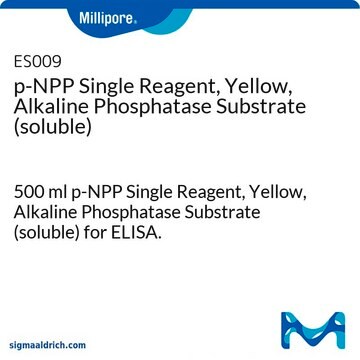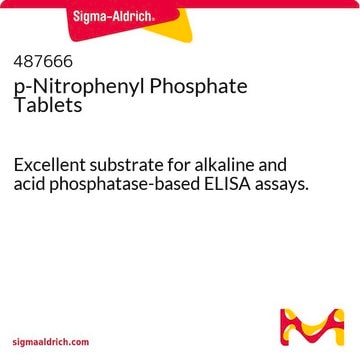N7653
p-Nitrophenyl Phosphate Liquid Substrate System
alkaline phosphatase substrate, liquid
Synonym(s):
4-Nitrophenyl phosphate disodium salt solution, pNPP
About This Item
Recommended Products
product name
p-Nitrophenyl Phosphate Liquid Substrate System, liquid
form
liquid
shipped in
wet ice
storage temp.
−20°C
SMILES string
[Na+].[Na+].[O-][N+](=O)c1ccc(OP([O-])([O-])=O)cc1
InChI
1S/C6H6NO6P.2Na/c8-7(9)5-1-3-6(4-2-5)13-14(10,11)12;;/h1-4H,(H2,10,11,12);;/q;2*+1/p-2
InChI key
VIYFPAMJCJLZKD-UHFFFAOYSA-L
General description
Application
Biochem/physiol Actions
Caution
Physical form
Signal Word
Danger
Hazard Statements
Precautionary Statements
Hazard Classifications
Eye Dam. 1 - Met. Corr. 1 - Repr. 2 - Skin Irrit. 2 - STOT RE 2 Oral
Target Organs
Kidney,Liver,Blood
Storage Class Code
8B - Non-combustible corrosive hazardous materials
WGK
WGK 3
Flash Point(F)
Not applicable
Flash Point(C)
Not applicable
Certificates of Analysis (COA)
Search for Certificates of Analysis (COA) by entering the products Lot/Batch Number. Lot and Batch Numbers can be found on a product’s label following the words ‘Lot’ or ‘Batch’.
Already Own This Product?
Find documentation for the products that you have recently purchased in the Document Library.
Customers Also Viewed
Our team of scientists has experience in all areas of research including Life Science, Material Science, Chemical Synthesis, Chromatography, Analytical and many others.
Contact Technical Service









